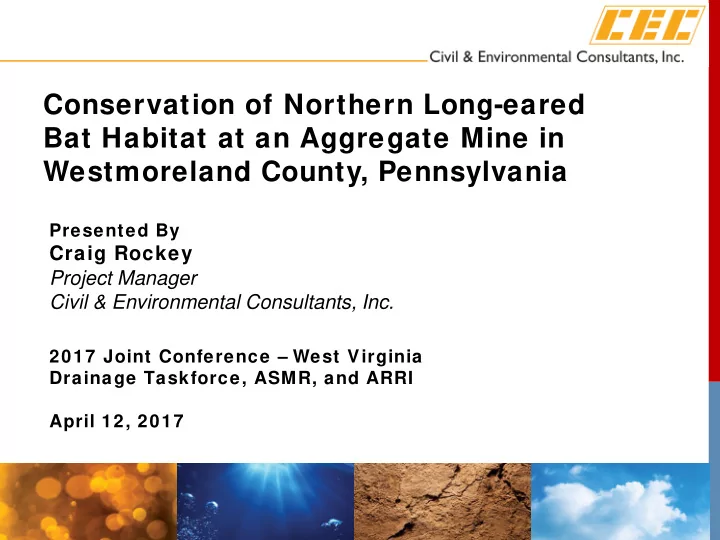

Conservation of Northern Long-eared Bat Habitat at an Aggregate Mine in Westmoreland County, Pennsylvania Presented By Craig Rockey Project Manager Civil & Environmental Consultants, Inc. 2017 Joint Conference – West Virginia Drainage Taskforce, ASMR, and ARRI April 12, 2017
Project Background ► Hanson Aggregate’s Wagner Quarry ▪ Expansion of existing limestone mine o Portal o Ventilation ▪ Originally permitted in 2013 ▪ 20 acres of surface disturbance 2
Project Background ► Activation in 2016 ▪ New Environmental Review (i.e., PNDI) required by PA DEP o Triggered agency involvement 3
Northern Long-eared Bat ( Myotis septentrionalis ) ► Small ► Insectivorous ► Migratory ► Slow reproduction, but long-lived ► Overlap with Indiana bat and little brown bat 4
Northern Long-eared Bat ► Winter ▪ Hibernate in caves and mines o Mid-October to mid-April ▪ Return to same area, if not same cave each year (philopatry or fidelity) 5
Northern Long-eared Bat ► Summer ▪ Migrate in late April and early May o Female bias ▪ Males form small bachelor colonies ▪ Females raise pups in roost trees (i.e., maternity colonies) 6
Northern Long-eared Bat ► Proposed for listing in August 2014 ► White-nose Syndrome ▪ Primary ► Habitat Loss ▪ Secondary 7
Northern Long-eared Bat ► Threatened with 4(d) rule – January 2016 ▪ Incidental Take* prohibited: o Within a hibernaculum o For tree clearing, within: ▪ .25 miles of hibernaculum ▪ 150 feet of maternity roost *Take is defined “to harass, harm, pursue, hunt, shoot, wound, kill, trap, capture, or collect” 8
Consultation with US Fish and Wildlife Service 9
Consultation with US Fish and Wildlife Service ► Meeting with USFWS ▪ Clarified impacts ▪ Explored Options o Reduce Impacts o Incidental Take Permit (HCP) ▪ No additional capture surveys 10
Consultation with US Fish and Wildlife Service ► Habitat Assessment ▪ Quantitative o Habitat Plots o Potential Roost Trees ▪ Qualitative o Roosting o Foraging 11
Improvement of Habitat – Artificial Roost Structures 12
Improvement of Habitat – Selective Clearing and Planting 13
Cave Gating ► Dual-purpose Habitat Improvement ▪ Northern long-eared bat ▪ Alleghany Woodrat ► Purpose ▪ Prevent disturbance by humans ▪ Maintain microclimate 14
Cave Gating 15
Cave Gating – 3D Lidar Scanning 16
Cave Gating – Design in AutoCAD 17
Cave Gating – 3D Lidar Scanning 18
Questions/Answers Thank You 19
Recommend
More recommend